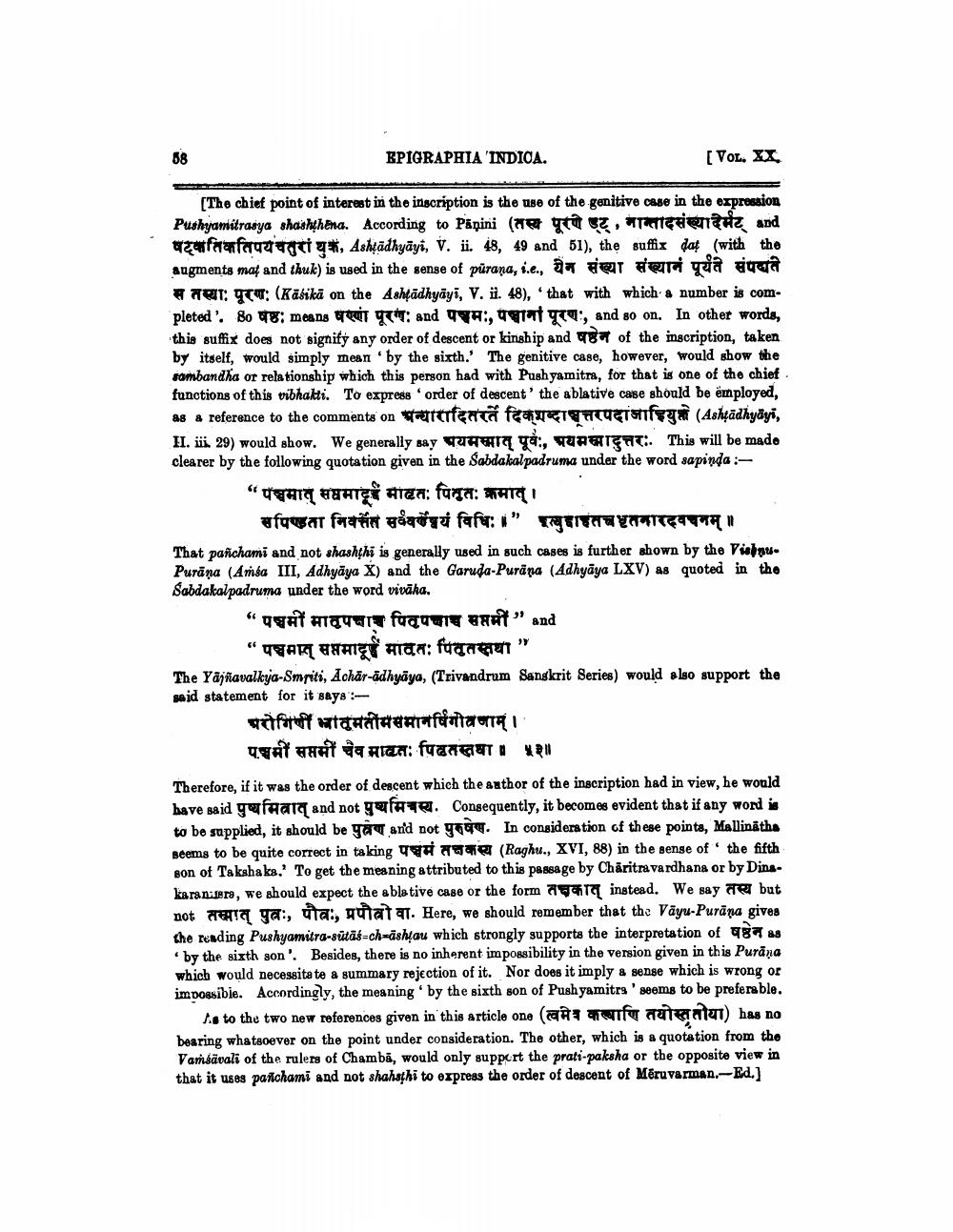________________
EPIGRAPHIA 'INDICA.
(VOL. XX
[The chief point of interest in the inscription is the use of the genitive case in the expression Pushyamitrasya shasthena. According to Pipini (तस्य पूरणे इट, मान्तादसंख्यादेमेंट and
#fanfara TTT Y*, Ashļādhyāyi, V. ii. 48, 49 and 51), the suffix dat (with the augments mat and thuk) is used in the sense of pūrana, i.e., 4 e per qua fuga #de: gem: (Käbikä on the Ashļādhyāyi, V. i. 48), that with which a number is completed'. 80 48: means u gatt: and A:, at , and so on. In other words, this suffix does not signify any order of descent or kinship and 877 of the inscription, taken by itself, would simply mean by the sixth. The genitive case, however, would show the sambandha or relationship which this person had with Pushyamitra, for that is one of the chief functions of this vibhakti. To express order of descent' the ablative case should be ennployed, as a reference to the comments on अन्धारादितरते दिशब्दावृत्तरपदाजाहियुक्तो (Ashtadhyayi, II. ii. 29) would show. We generally say QUASI #, VARIGHT:. This will be made clearer by the following quotation given in the Sabdakalpadruma under the word sapinda :
"YAT HATER Ada: farca: TATTI
सपिण्डता निवसंत सर्ववर्येषयं विधिः।" प्रत्युवाहतच कृतनारदवचनम्। That panchami and not shashthi is generally used in such cases is further shown by the Vishnu Purāna (Amsa III, Adhyāya X) and the Garuda-Purära (Adhyāya LXV) as quoted in the Sabdakalpadruma under the word vivāha.
“uyat ATQYw1 faquule anait" and
"TPAR UNHIEJ Haa: fuqareten” The Yājñavalkya-Smriti, Achār-ādhyāya, (Trivandrum Sanskrit Series) would also support the said statement for it says -
diforuff atanataeftititor QyAt what AIWA: TAFUT NON
Therefore, if it was the order of descent which the author of the inscription had in view, he would have said gefral and not gethe. Consequently, it becomes evident that if any word is to be supplied, it should be gant and not go . In consideration of these points, Mallinātha Beems to be quite correct in taking UYU
(Raghu., XVI, 88) in the sense of the fifth son of Takshaka. To get the meaning attributed to this passage by Chăritravardhana or by Dinakarani:fera, we should expect the ablative case or the form at instead. We say he but not तस्मात् पुनः, पौवः, प्रपौवो वा. Here, we should remember that the Vāya-Purana gives the reading Pushyamitra-sūtās=ch-äshļau which strongly supports the interpretation of 287 as .by the sixth son'. Besides, there is no inherent impossibility in the version given in this Purāna which would necessitate a summary rejection of it. Nor does it imply & senge which is wrong or impossible. Accordingly, the meaning' by the sixth son of Pushyamitra' seems to be preferable.
Le to the two new references given in this article one (@* fu aratat) has no bearing whatsoever on the point under consideration. The other, which is a quotation from the Vańsävali of the rulers of Chambā, would only support the prati-paksha or the opposite view in that it uses panchami and not shahathi to express the order of descent of Mēru varman-Ed.]




